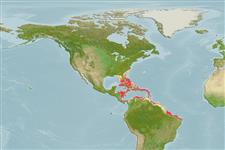Environment: milieu / climate zone / depth range / distribution range
Ecologie
marien rifbewoner; standvastig; diepte 3 - 92 m (Ref. 9710), usually 3 - 35 m (Ref. 40849). Tropical; 37°N - 29°S, 100°W - 28°W (Ref. 55266)
Western Atlantic: Georgia (USA), Bermuda, and northern Gulf of Mexico to Santa Catarina, Brazil (Ref. 57756).
Lengte bij maturiteit / Grootte / Gewicht / Leeftijd
Maturity: Lm 15.8 range ? - ? cm
Max length : 35.0 cm TL mannelijk / geslacht onbekend; (Ref. 3797); common length : 30.0 cm TL mannelijk / geslacht onbekend; (Ref. 3797)
Dorsale stekels (totaal): 14; Dorsale zachte stralen (totaal): 17-19; Anale stekels 3; Anale zachte stralen: 18 - 20. Front of body yellow; remaining parts of body, dorsal fin, and front of anal fin black. Caudal fin entirely yellow (Ref. 26938). Front margin of anal fin and edge of gill cover orange; bright blue on upper and lower part of iris. The young of about an inch in length are entirely yellow except for a blue-edged black spot on the upper side of the body posterior to the midpoint; with growth the black spot soon expands to become the large black area covering most of the body and dorsal and anal fins (Ref. 13442).
Inhabits rock jetties, rocky reefs and rich coral areas. Juveniles often associated with fire corals (Ref. 9710). Feeds on tunicates, sponges, zoantharians and algae. Marketed fresh (Ref. 3797).
Levenscyclus en paargedrag
Maturiteit | Voortplanting | Paaien | Eieren | Fecunditeit | Larven
Protogyny has been proposed for this species awaiting confirmation (Ref. 103751).
Allen, G.R., 1985. Butterfly and angelfishes of the world. Vol. 2. 3rd edit. in English. Mergus Publishers, Melle, Germany. (Ref. 4858)
Status op de Rode Lijst van het IUCN (Ref. 130435)
Gevaar voor de mens
Reports of ciguatera poisoning (Ref. 30303)
Gebruik door de mens
Visserij: van minder commercieel belang; Aquarium: Commercieel
Meer informatie
ReferentiesAquacultuurAquacultuurprofielKweeklijnenGeneticaElectrophoresesErfelijkheidZiektesVerwerkingNutrientsMassaconversie
Tools
Speciale rapporten
Download XML
Internetbronnen
Estimates based on models
Preferred temperature (Ref.
123201): 25.4 - 28, mean 27.4 °C (based on 220 cells).
Fylogenetische diversiteitsindex (Ref.
82804): PD
50 = 0.5078 [Uniqueness, from 0.5 = low to 2.0 = high].
Bayesian length-weight: a=0.03311 (0.01745 - 0.06285), b=2.89 (2.72 - 3.06), in cm total length, based on LWR estimates for this species & (Sub)family-body (Ref.
93245).
Trofisch niveau (Ref.
69278): 3.0 ±0.0 se; based on diet studies.
Weerstandsvermogen (Ref.
120179): laag, minimale populatieverdubbelingstijd 4,5-14 jaar (Preliminary K or Fecundity.).
Fishing Vulnerability (Ref.
59153): Low vulnerability (25 of 100).
Nutrients (Ref.
124155): Calcium = 42.5 [21.5, 68.9] mg/100g; Iron = 0.511 [0.313, 0.828] mg/100g; Protein = 18.3 [17.1, 19.5] %; Omega3 = 0.104 [0.067, 0.163] g/100g; Selenium = 37 [21, 69] μg/100g; VitaminA = 65 [18, 234] μg/100g; Zinc = 1.23 [0.86, 1.72] mg/100g (wet weight);
